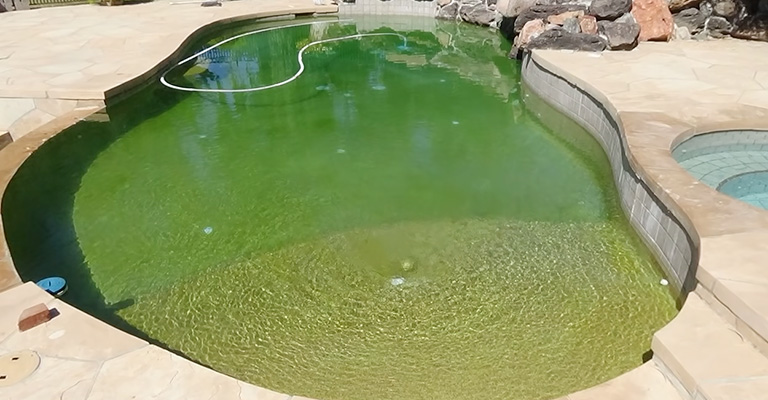Picture this: a hot summer day, the sun shining brightly, and your pool glistening invitingly in the backyard. It’s the perfect setting for a refreshing swim and a much-needed escape from the scorching heat.
However, as you approach your pool, you notice a greenish tint on the water’s surface and slimy patches along the walls. Algae has made its way into your pool, and it’s time to take action.
Algae, the bane of every pool owner’s existence, can quickly turn your backyard oasis into an unsightly and unhealthy environment.
To remove algae from your pool, use a pool brush to thoroughly scrub any surface covered in algae, including the walls, floors, and steps.
Follow the label directions when applying a green algaecide. Afterwards, brush the pool surfaces once more after letting the water circulate for 24 hours. You should also deep clean your pool filter.
If there are any dead algae left, vacuum them up or backwash them. Let me go over the steps in details. With the proper knowledge and a proactive approach, you can bid farewell to algae and restore your pool to its pristine condition.
Here Is Your Go-To Guide for Wiping Out Any Type of Pool Algae
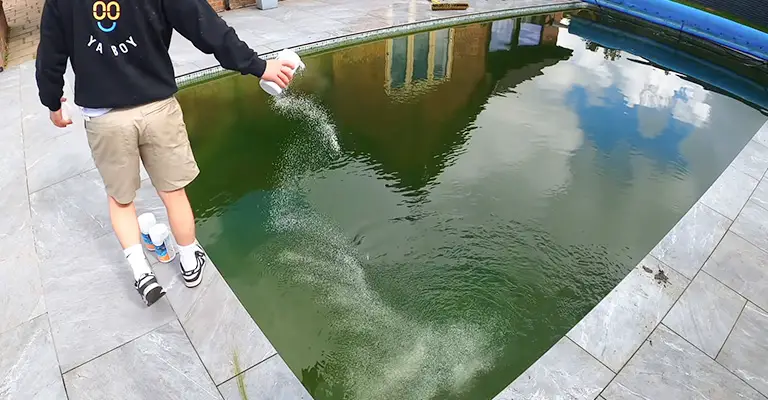
You can quickly get rid of algae from your swimming pool on your own. However, it is a common problem.
A living plant organism, algae, can suddenly appear in the environment. As a result, your pool filters can clog, water circulation decreases, and pool chemicals are less effective.
Several factors can contribute to algae blooming, such as low chlorine levels, heavy rains and high temperatures. Listed below are the steps to getting rid of algae from a pool.
How to Treat Black Algae?
As an organism, black algae is very stubborn. In addition to protecting itself, its outer layer embeds roots in the surfaces on which it grows. Because of this, it is one of the toughest algae strains to eradicate.
A black spot appears on a pool’s surface due to black algae. To treat the fungus effectively, a good deal of scrubbing is needed. This is how you can remove green algae from your pool:
- Pool test kits help you balance your pool’s chemicals and pH.
- If any residual chlorine remains, apply a pool shock product according to the instructions on the label.
- You can remove the black algae with a stiff-bristled brush or a pumice stone (on plaster pools only).
- You should vigorously scrub all the areas affected by black algae with a pool brush.
- Make sure all algae debris is vacuumed.
- According to the label directions, apply a black algae treatment to the affected area.
- It is best to let the water circulate for 24 hours.
- Clean the water’s surface by vacuuming or backwashing the dead algae. Attempt to remove the algae again in two to four days if necessary.
Once you have completed these steps, you should check your pool water to ensure that it is within its ideal range:
- Free chlorine (1 – 4 ppm)
- PH (7.2 – 7.6)
- Alkalinity (80 -150)
- Calcium hardness (200 – 275)
How To Treat Mustard Algae?
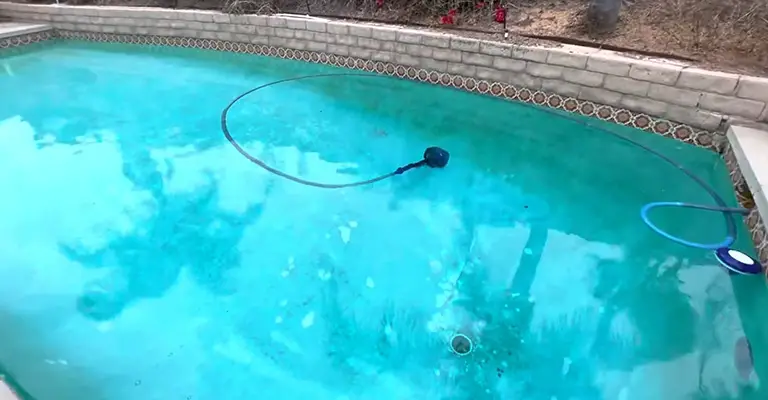
Green algae are more common, while mustard algae are yellow. In addition, removing it is more complicated.
You may notice mustard algae in your pool when it appears as yellowish-brown or dirt-colored spots on your walls and floor. It is pretty easy to brush mustard algae away from the pool’s surface, but the algae can return quickly after brushing.
In addition to that, mustard algae can adhere to anything entering the pool, which makes it so difficult to remove.
Having removed the algae, thoroughly cleaned everything that has had contact with the water, including toys and swimsuits. Here are the steps to remove mustard algae from your pool:
- Utilize a test kit to test and balance your pool’s chemical levels.
- Adding a quality pool shock product according to label instructions can boost any residual chlorine.
- You can aggressively scrub the surfaces that have been affected by algae with a pool brush. Using a vacuum or backwash will help remove dead algae from the pool.
- The application of mustard algaecide must be made according to the directions on the label. After 24 hours, allow the water to circulate.
- Using a pool vacuum or backwashing the pool will remove the remaining dead algae. If the problem persists, brush the pool and apply algaecide once more over a two-four-day period.
Make sure your pool chemicals and levels have been balanced after treatment. These ranges are ideal:
- Free chlorine (1 – 4 ppm)
- pH (7.2 – 7.6)
- Alkalinity (80 – 150)
- Calcium hardness (200 – 275)
How to Treat Green Algae?
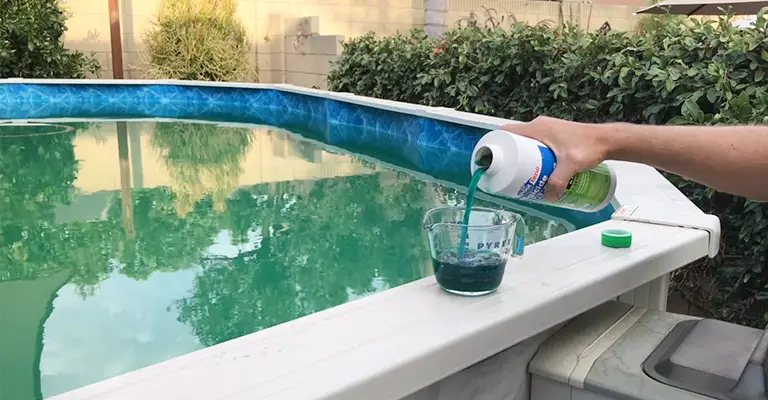
You may encounter green algae in your swimming pool most often. In the presence of this type of algae, the water appears murky, with a greenish tint. It forms free-floating clouds, which make the water look greenish.
Additionally, green algae stick to the pool’s floor and walls, causing them to slip. In terms of prevention and treatment, green algae are the easiest to deal with.
This is how you can remove green algae from your swimming pool:
- The pH level of your pool, stabilizer level, and chlorine level can be checked with a pool water test kit.
- To boost residual chlorine in the swimming pool, add a pool shock product. You should carefully follow the directions on the label.
- To rid your pool of algae, scrub all surfaces aggressively with a pool brush. This includes walls, floors, and stairways.
- Following the label’s directions, apply a green algaecide.
- Once the water has circulated for 24 hours, brush the pool surfaces once more.
- Make sure any dead algae is removed by vacuuming or backwashing.
To ensure that all levels are within the ideal range, take another sample of your pool water after completing these steps:
- Free chlorine (1 – 4 ppm)
- pH (7.2 – 7.6)
- Alkalinity (80 – 150)
- Calcium hardness (200 – 275)
What Causes Pool Algae?
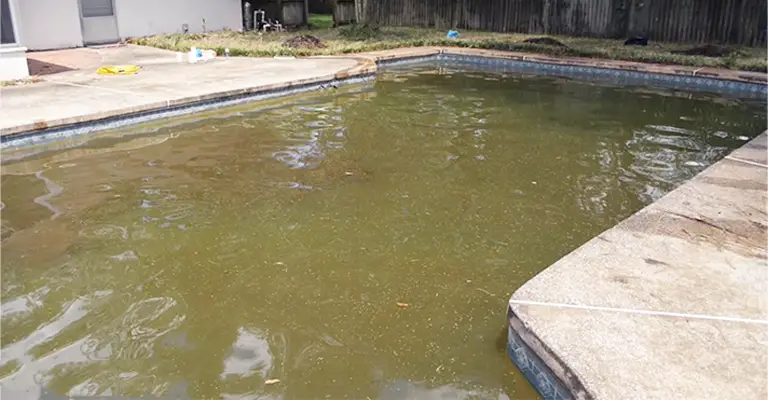
Almost everywhere you look, algae spores are present. They can enter your swimming pool through rain, dirt, and even the wind.
These pervasive algae spores become problematic when they multiply in your pool water, cause an algae bloom, or grow on your pool’s walls.
When chlorine levels are low, pH levels are improper, filters are dirty, or the circulation is not good, algae growth is a certainty.
In addition, bugs can be introduced by contaminated swimwear or toys used in rivers, ponds, lakes, or oceans. In comparison to treating an existing significant problem with algae, preventing algae is much easier.
To prevent this from happening, keep your pool water balanced, clean your filter system, and take care to wash any swimwear or toys that have been used in natural bodies of water.
What Are The Different Types Of Pool Algae?
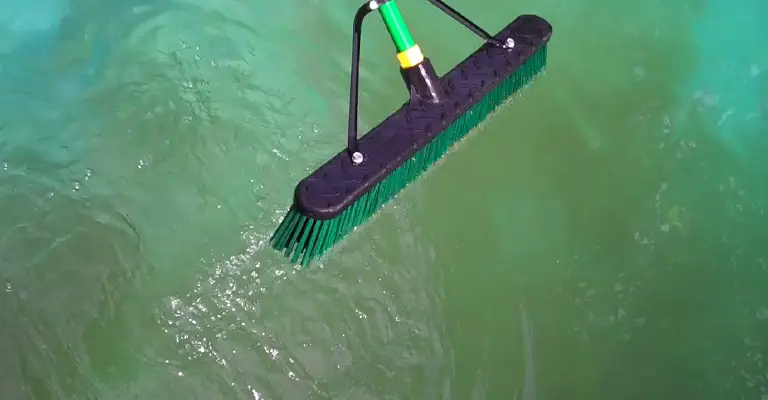
Identifying the type of pool algae you have will assist you in treating it. To begin with, you must determine what color algae is in your pool. You’ll find a complete guide on how to get rid of algae if you continue reading.
Green Pool Algae
Algae in swimming pools are usually green and the easiest to kill. Floating-green algae bloom spreads quickly, causing algae slime to form on pool surfaces and cloud the water.
A vacuum will remove the algae from your pool; you will need to brush and vacuum it, and then you will need to shock and filter your pool water. Algae are colored teal green to dark, blackish green, depending on severity.
Yellow Pool Algae
Yellow pool algae, also known as brown algae or mustard algae, is rarer and found in humid climates. You may notice globs of pollen or sand adhering to the shady corners of your pool.
In addition, it is chlorine resistant. The most effective way to kill mustard algae is by brushing your pool surfaces multiple times and adding extra shock to your pool water.
Black Pool Algae
Rather than algae, black pool algae is made up of bacteria. The roots of this plant penetrate concrete surfaces, making it extremely hard to eradicate.
To get rid of black algae, you need several rounds of deep cleaning, and if you don’t thoroughly clean your home, it will return within a few days.
Can You Use Algaecide to Get Rid of Pool Algae?
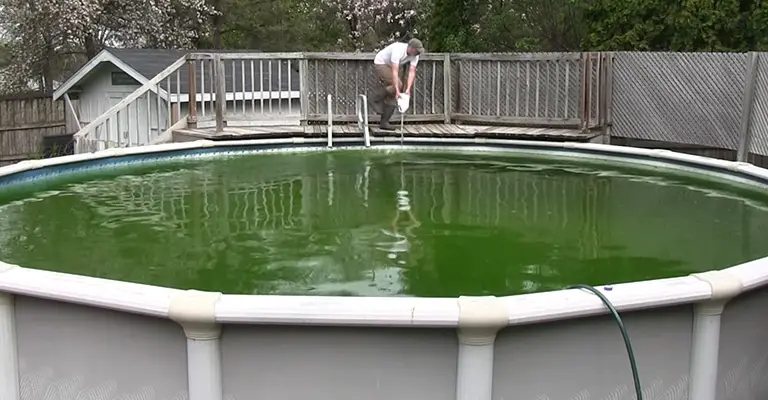
It is technically possible to kill algae with an algaecide. It’s not recommended to remove large algae infestations. When compared to chlorine, algaecide is extremely expensive.
In addition, it introduces a lot of copper to your pool water. In the meantime, algaecide effectively controls small amounts of algae and prevents algae growth at a very early stage.
Also, you can use an algaecide to kill off left-over algae after you’ve cleaned your pool. Following vacuuming, brushing, and shocking your pool, wait until your chlorine levels are below 5 parts per million.
Once that is done, add an algaecide. You should brush your pool once a week to remove any remaining algae you cannot see. In addition to killing any remaining algae particles, the algaecide will also assist in filtering them out.
Pool Algae Control & Prevention
Many factors contribute to the growth of pool algae. A poor pool filtration system, low chlorine levels, or poor circulation may all contribute to low chlorine levels.
To keep your pool fully functional all season long, you need to keep the algae from flourishing. Maintaining your pool regularly is essential for keeping it algae-free.
Listed below are a few tips to help you keep algae from flourishing again.
- Maintain balanced pool water by testing it weekly. pH levels in swimming pools should range from 7.2 to 7.6.
- Make sure your water circulator is working correctly by checking your filter system weekly.
- Ensure that all surfaces around your pool (walls, floors, and steps) are brushed weekly so algae is not able to grow.
- For cloudy pool water, shock it weekly to remove contaminants.
- A preventative dose of an algaecide should be added every week after shocking your pool. The use of algaecides not only kills algae but can also delay its growth.
- Clean all swimwear and toys that have been in natural water bodies before using the pool to prevent algae transfer.
Does Shock Kill Algae In Pools?
For algae to die in pools, shock is essential. A shock treatment raises the levels of free chlorine in your pool water until contaminants, such as algae, are destroyed.
Adding 2-4 doses of shock may be necessary, depending on the severity of your algae growth. After killing algae with shock, water should appear cloudy. You should see clearer water after running your filter.
You should clean your pool and vacuum it before using shock. A large amount of algae is removed and loosened up as a result.
Does Phosphate Remover Kill Algae In Pools?
An algae nutrient remover works by cutting off its nutrient source. Water with more phosphates is more likely to have algae growing on it.
In addition, phosphate removers won’t fix underlying water chemistry problems, such as low chlorine levels or a poor pH balance.
Your pool won’t need a phosphate remover so long as you use chlorine, algaecide, and occasional pool shocks.
How Do You Treat Algae In Saltwater Pools?
Algae can be removed from a saltwater pool in precisely the same manner as from a chlorine pool. You’re in a chlorine pool whenever you swim in a saltwater pool.
Adding salt will generate chlorine instead of a chemical. In the same way, you would use calcium hypochlorite shock to shock a chlorine pool; you will need to use calcium hypochlorite shock for your calcium hypochlorite pool.
Can You Swim In A Pool With Algae?
Technically, yes; however, it’s not recommended. Even though algae are not harmful to swimmers, pools with a high density of algae contain pathogens and bacteria that can cause illness.
Having cloudy water can also pose a hazard for swimmers who cannot see the bottom of the pool. Swim in a properly sanitized and cleaned pool rather than one that isn’t.
Conclusion
You’ll be able to prevent algae growth in the pool easily once you know how to get rid of it and treat it as needed. You can quickly eliminate green algae, black algae, and mustard algae if you deal with the problem as soon as possible.

